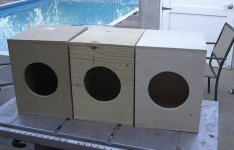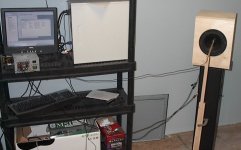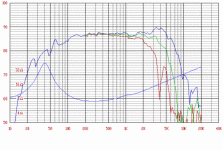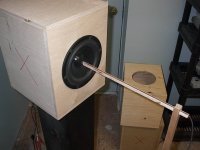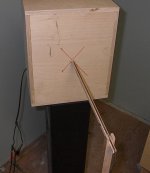Re: Re: What to build speakers out of... multilayered construction?
It is very wastefull, but so is building something you are not satisfied with. This method can produce wild shapes that would be VERY difficult to do otherwise. Use of MDF is cheap, but you need to make sure that the finish is not water based, as this will make it swell.
Using a void free plywood, and leaving it to show the laminations could look very attractive, especially if stained a darker colour.
CNC router would be good, but it can be done with hand tools. A pattern for a follower bit in your router for the outside shape; the inside could be cut wit a jigsaw, it doesn't have to be perfect.
I've considered using this method in the past, but hate to waste even a small morsel of my precious MDF😉
showflash said:I was thinking about building speakers using a multi-layered construction. Does anyone have any feeling one way or the other with regard to the construction of the Pioneer TAD Model 1 or speakers like it?
It is very wastefull, but so is building something you are not satisfied with. This method can produce wild shapes that would be VERY difficult to do otherwise. Use of MDF is cheap, but you need to make sure that the finish is not water based, as this will make it swell.
Using a void free plywood, and leaving it to show the laminations could look very attractive, especially if stained a darker colour.
planet10 said:
...need to have access to a CNC this technique is very good.
CNC router would be good, but it can be done with hand tools. A pattern for a follower bit in your router for the outside shape; the inside could be cut wit a jigsaw, it doesn't have to be perfect.
I've considered using this method in the past, but hate to waste even a small morsel of my precious MDF😉
Quoting JohninCR
"Was that a box or OB? Imagine the noise at the edges with real wood instead of MDF. Typical approaches do little to address what we're hearing at the edges other than decoupling the driver frame from structure. I'm sure that something more is needed to prevent sound from entering the structure at the driver cutout where SPL's are their highest by using some damping material there and/or dissipating the energy that enters the baffle there."
John, that was the small OB I was telling you about. What it revealed was two modes of energy flow. That coming off the face of the baffle, and that flowing down the baffle. Picture the 5 balls hanging by string. The outside balls oscillate back and forth, the middle ones dont move.
In the case of a baffle, the energy flowing down the baffle can't do much, until it reaches a surface with sufficient radiation resistance, and the kinetic energy is transferred to acoustic energy. What doesn't get transferred at the edge of the baffle, bounces round till it's at a suitable angle to excite the panel. This suggests we need to address how the baffle is supported on the cabinet. I am thinking of placing a bend at the end of a baffle, with suitable radius. That may kill off some of the higher frequency components the same way a folded horn does.
If my suggestion is in the right paddock, we need to look for a material that is moldable, or at least formable, with a known grain structure. That rules out MDF and particle board.
Poplar may be a candidate. Very fine and straight grained hardwood. I think it is difficult to peel off veneers.
However, driver mounting is also important, ie kill the problem before it gets too far in time.
Regards,
Geoff.
"Was that a box or OB? Imagine the noise at the edges with real wood instead of MDF. Typical approaches do little to address what we're hearing at the edges other than decoupling the driver frame from structure. I'm sure that something more is needed to prevent sound from entering the structure at the driver cutout where SPL's are their highest by using some damping material there and/or dissipating the energy that enters the baffle there."
John, that was the small OB I was telling you about. What it revealed was two modes of energy flow. That coming off the face of the baffle, and that flowing down the baffle. Picture the 5 balls hanging by string. The outside balls oscillate back and forth, the middle ones dont move.
In the case of a baffle, the energy flowing down the baffle can't do much, until it reaches a surface with sufficient radiation resistance, and the kinetic energy is transferred to acoustic energy. What doesn't get transferred at the edge of the baffle, bounces round till it's at a suitable angle to excite the panel. This suggests we need to address how the baffle is supported on the cabinet. I am thinking of placing a bend at the end of a baffle, with suitable radius. That may kill off some of the higher frequency components the same way a folded horn does.
If my suggestion is in the right paddock, we need to look for a material that is moldable, or at least formable, with a known grain structure. That rules out MDF and particle board.
Poplar may be a candidate. Very fine and straight grained hardwood. I think it is difficult to peel off veneers.
However, driver mounting is also important, ie kill the problem before it gets too far in time.
Regards,
Geoff.
Re: Re: What to build speakers out of... multilayered construction?
Regarding the CNC machines...
I have a very close friend that used to run his own machine shop, where he used to make scope parts for a large manufacturer. He said he would help me develop a jig that would allow me to cut the wood with a plunge router. Not sure if he knows how much work this is going to be because he ran a machine shop and this is wood work but I am all ears at this time.
The shape that I am shooting for at this time is not square. I am looking at cylinders with a minimalist edge diffraction tilt along the creative concept Vandersteen 5A or the 40th anniversary B&W. I know these are far apart but I am only at the research stage at this time.
I was thinking about using the Green Glue posted earlier between the pieces, sand all edges on the exterior once dry, and then coat the interior with epoxy, exterior with varnish. Steel rods to bolt it together like the TAD.
Regarding the CNC machines...
I have a very close friend that used to run his own machine shop, where he used to make scope parts for a large manufacturer. He said he would help me develop a jig that would allow me to cut the wood with a plunge router. Not sure if he knows how much work this is going to be because he ran a machine shop and this is wood work but I am all ears at this time.
The shape that I am shooting for at this time is not square. I am looking at cylinders with a minimalist edge diffraction tilt along the creative concept Vandersteen 5A or the 40th anniversary B&W. I know these are far apart but I am only at the research stage at this time.
I was thinking about using the Green Glue posted earlier between the pieces, sand all edges on the exterior once dry, and then coat the interior with epoxy, exterior with varnish. Steel rods to bolt it together like the TAD.
Re: Re: Re: What to build speakers out of... multilayered construction?
You don't want to go by chris' work when you come to visit then... 3 dumpsters a week hauled away.
dave
MJL21193 said:but hate to waste even a small morsel of my precious MDF😉
You don't want to go by chris' work when you come to visit then... 3 dumpsters a week hauled away.
dave
Seventh Veil
also search on the forum... there was a thread that helped a bit in the development
dave
also search on the forum... there was a thread that helped a bit in the development
dave
Re: Re: Re: Re: What to build speakers out of... multilayered construction?
Green glue is for constrained layer damping. You will not have to use this technique as your box(as discribed) will not have panels that are suseptable to resonsnce. In other words, I'd use real glue (yellow PVA carpenters glue, or polyurethane glue). Not sure about the value of the epoxy on the inside, but wouldn't hurt. Steel rods to bolt it is good to clamp it all together while the glue dries.
Shocking!🙁
showflash said:
I was thinking about using the Green Glue posted earlier between the pieces, sand all edges on the exterior once dry, and then coat the interior with epoxy, exterior with varnish. Steel rods to bolt it together like the TAD.
Green glue is for constrained layer damping. You will not have to use this technique as your box(as discribed) will not have panels that are suseptable to resonsnce. In other words, I'd use real glue (yellow PVA carpenters glue, or polyurethane glue). Not sure about the value of the epoxy on the inside, but wouldn't hurt. Steel rods to bolt it is good to clamp it all together while the glue dries.
planet10 said:
You don't want to go by chris' work when you come to visit then... 3 dumpsters a week hauled away.
Shocking!🙁
MJL21193 said:
OK, since everyone says there is such a hugh difference in materials, here's what I will do:
I will build three boxes, of three different materials - one of MDF, one from baltic birch plywood, and the third from cheap spruce sheathing. I will construct each box from the same thickness material (1/2"). I will build each the same way - with glue and 1.5" airgun nails. They will be identical in every way. I will make one hole for a midbass driver that has a normal Xmas~5mm.
I will then test each box for panel resonance, using nearfield frequency response with the mic 1/2" from the largest panel.
There will be no damping material, the boxes will be empty sealed boxes.
Will assemble the MDF box and spruce sheating box tomorrow. Ready to test by next weekend.
planet10 said:
not baltic birch?
dave
Way back in post #152 there's a pic of the baltic birch box already constructed. Remember? Just had to pick up some 1/2 inch MDF, as I have none on hand.
MJL21193 said:
Way back in post #152 there's a pic of the baltic birch box already constructed. Remember? Just had to pick up some 1/2 inch MDF, as I have none on hand.
Nope missed that (or it passed from my brain "))... looking forward to your results
dave
planet10 said:
... looking forward to your results
More on my materials test:
Finished the spruce box and MDF box on Thursday. Ran some preliminary test today with suprising results...
Will do the full scientific test procedure tomorrow and start posting the results.
One problem - I can't figure out how to copy the charts from Speaker Workshop to post as images. If anyone has any ideas, let me know.
MJL21193 said:
One problem - I can't figure out how to copy the charts from Speaker Workshop to post as images. If anyone has any ideas, let me know.
😀 😱 I figured it out - prtscr key, paste to paint, save as GIF.
The test equipment: Speaker Workshop, Wallin jig with built in mic pre-amp (Eric Wallin design) plus LM3886 based power amp. Homemade mic (Panasonic capsule), homemade mic stand.
Running on a Celeron 1GHz with a SoundBlaster sound card. Only use for this computer is this purpose.
Running on a Celeron 1GHz with a SoundBlaster sound card. Only use for this computer is this purpose.
Attachments
claudio said:
one question: cheap spruce is the same as particle board also known as chipboard?
Hi.
Claudio: spruce plywood for house construction - 4 plys, cheap and rough. Not particle board or chip board.
The box in the middle on the photo above.
After much experimentation with different power levels, I settled on ~1 volt for these nearfield tests, which is quite loud in a small room BTW. Placing the test box on an old speaker cabinet, with a piece of carpet between the two. Position the mic ~ 1/2" from the cones dustcap, to get the drivers freq. response in each box.
The objective is to determine if the box material has an effect on the sound from the driver itself.
The objective is to determine if the box material has an effect on the sound from the driver itself.
Attachments
Next is the nearfield frequency response of the side panel. As shown in the pic, an "x" marks the exact centre. With the same settings on the amp and Speaker Workshop, I run the test.
I tried several different things during this test, such as putting a plywood shield to block some of the sound from the cone, but nothing had much of an effect. I even used a thick towel draped over the box, covering the driver. This made very little difference.
In the end, I just left the box as pictured, running the test 3 to 4 times to verify consistancy.
After all, it's the audible qualities of the box material in question. If the side panel test has some influence from the driver, that's not unlike the real world situation, where the listener will experience both combined.
I tried several different things during this test, such as putting a plywood shield to block some of the sound from the cone, but nothing had much of an effect. I even used a thick towel draped over the box, covering the driver. This made very little difference.
In the end, I just left the box as pictured, running the test 3 to 4 times to verify consistancy.
After all, it's the audible qualities of the box material in question. If the side panel test has some influence from the driver, that's not unlike the real world situation, where the listener will experience both combined.
Attachments
- Home
- Design & Build
- Construction Tips
- Discussion on what materials to build speakers out of
